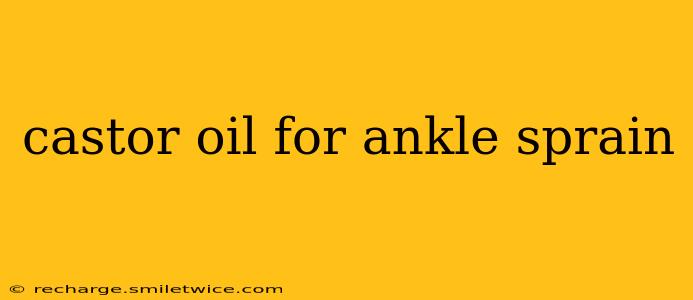Ankle sprains are a common injury, often caused by a sudden twisting or rolling of the ankle. While conventional treatments like RICE (rest, ice, compression, elevation) and physical therapy are widely recommended, some individuals explore alternative therapies, including the use of castor oil. This article delves into the potential benefits and limitations of using castor oil for ankle sprains, addressing common questions and concerns.
What is Castor Oil and How Does it Work?
Castor oil, extracted from the seeds of the castor bean plant (Ricinus communis), is a thick, viscous oil known for its high ricinoleic acid content. Ricinoleic acid possesses anti-inflammatory and analgesic properties, meaning it can potentially reduce swelling and pain. While not a direct treatment for a sprained ankle in the way that RICE therapy is, some believe its anti-inflammatory action could aid in the healing process. It's important to note that scientific evidence supporting its efficacy in treating ankle sprains specifically is limited.
Can Castor Oil Reduce Swelling in a Sprained Ankle?
This is a key question many people ask. Ricinoleic acid's anti-inflammatory properties could theoretically help reduce swelling associated with an ankle sprain. However, it's crucial to understand that castor oil is not a substitute for proper medical care. While it might offer some minor relief from swelling as part of a holistic approach, it won't address the underlying ligament damage. Reducing swelling primarily relies on the initial RICE method and subsequent physical therapy. Castor oil may offer a supplementary benefit, but its effectiveness is not definitively proven.
Does Castor Oil Help with Ankle Pain After a Sprain?
Similar to its potential effect on swelling, castor oil's analgesic properties might provide some pain relief. Again, this is largely anecdotal, and controlled studies on its efficacy for ankle sprain pain are lacking. The pain relief experienced, if any, is likely minimal and shouldn't be relied upon as the primary pain management strategy. Over-the-counter pain relievers and proper medical treatment remain the most effective options for managing ankle sprain pain.
How to Apply Castor Oil for Ankle Sprains (If Choosing to Use It)?
If you choose to use castor oil as a supplementary measure, it's recommended to apply a small amount to the affected area after thoroughly cleaning the skin. Gently massage the oil into the skin around the ankle, avoiding direct application to any open wounds. You can cover the area with a bandage to retain warmth and help the oil absorb. It’s crucial to remember that this is not a treatment but a potential supplementary aid.
Is Castor Oil Safe to Use on a Sprained Ankle?
Generally, castor oil is considered safe for topical application on the skin. However, some individuals might experience allergic reactions, such as redness, itching, or rash. It's vital to perform a patch test on a small area of skin before applying it extensively to the ankle. If you experience any adverse reactions, discontinue use immediately.
What are the Side Effects of Using Castor Oil on a Sprained Ankle?
The most common side effect is an allergic reaction, manifesting as skin irritation. Other potential side effects are rare but could include nausea or diarrhea if ingested (which should never happen when treating a sprained ankle). Always prioritize the advice of a medical professional before using alternative therapies.
When Should I See a Doctor for an Ankle Sprain?
This is the most important question. While castor oil might offer minor supplementary benefits, it is not a replacement for proper medical attention. You should consult a doctor immediately if you suspect an ankle sprain, especially if:
- You experience severe pain.
- You cannot bear weight on your ankle.
- There is significant swelling or bruising.
- You hear a popping sound at the time of injury.
- You have numbness or tingling in your foot.
This information is intended for educational purposes only and should not be considered medical advice. Always consult with a healthcare professional for diagnosis and treatment of any medical condition, including ankle sprains. They can accurately assess your injury and provide the most effective treatment plan. Remember, proper medical care is crucial for ensuring a full and speedy recovery from an ankle sprain.
